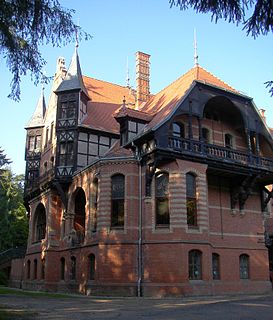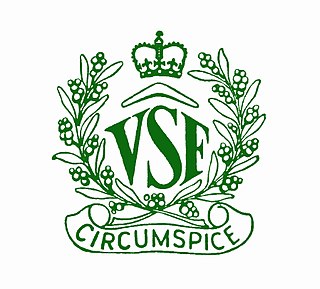
A forester's lodge, forester's house or forester's hut is the residence of a forester, usually one who is in charge of a forest district.

A forester's lodge, forester's house or forester's hut is the residence of a forester, usually one who is in charge of a forest district.
Woodcutters' huts are as old as forestry itself. To begin with, temporary accommodation was usually built for the clearing of areas of forest, but they became more permanent in the High Middle Ages in Europe as more and more timber was felled for mining, saltworks, shipbuilding and firewood, in order to reduce the distance from home to workplace. The foresters could remain in an area of timber felling for weeks. With the development of forestry rights, the profession of foresters emerged and so the forester's lodge became a place of work. In some cases, large forester's estates were created.
Usually forester's houses are solid, brick-built structures that are often permanently occupied, for example as forestry administrative offices, and usually in or near settlements, while forester's huts are less well built, simpler shelters and overnight accommodation in the more remote regions of a forest district. Even today, a forester's house and several forester's huts may be only temporarily constructed in a larger forest district, during forest management work. The development of forest tracks and logging lorries, however, has meant that overnighting on site is no longer necessary in Central Europe, but is still common in the large forests of northern Europe. Sometimes a combined site is used for hunting and forestry (in Germany referred to as a Hegerhaus).
Together with hunting lodges, alm huts and other transhumance stations, and mountain huts, forest lodge and huts are among the most important settlement forms of the sparsely populated areas such as large forests or highlands, where they are not located within settlements. [1]
Forest houses in Europe have a certain architecture, that is both designed to be in keeping with the countryside and also to be recognisable for what they are . Thus they often occupy an exposed site. A stag's head is often placed above the entrance or on a gable.
Occasionally forester's houses have a defensive character. For example, the 1812 lodge of Schießhaus in the Solling was surrounded by a defensive wall with embrasures. [2]

Forestry is the science and craft of creating, managing, planting, using, conserving and repairing forests, woodlands, and associated resources for human and environmental benefits. Forestry is practiced in plantations and natural stands. The science of forestry has elements that belong to the biological, physical, social, political and managerial sciences.

A forester is a person who practices forestry, the science, art, and profession of managing forests. Foresters engage in a broad range of activities including ecological restoration and management of protected areas. Foresters manage forests to provide a variety of objectives including direct extraction of raw material, outdoor recreation, conservation, hunting and aesthetics. Emerging management practices include managing forestlands for biodiversity, carbon sequestration and air quality.

Parkend is a village, located at the foot of the Cannop Valley, in the Royal Forest of Dean, West Gloucestershire, England, and has a history dating back to the early 17th century. During the 19th century it was a busy industrial village with several coal mines, an ironworks, stoneworks, timber-yard and a tinplate works, but by the early 20th century most had succumbed to a loss of markets and the general industrial decline. In more recent times, the village has found new life within the tourism sector, primarily as a centre for the provision of tourist accommodation.

A log cabin is a small log house, especially a less finished or less architecturally sophisticated structure. Log cabins have an ancient history in Europe, and in America are often associated with first generation home building by settlers.

A cottage is typically a small house. It may carry the connotation of being an old or old-fashioned building. In modern usage, a cottage is usually a modest, often cosy dwelling, typically in a rural or semi-rural location. The cottage orné, often quite large and grand residences built by the nobility, dates back to a movement of "rustic" stylised cottages of the late 18th and early 19th century during the Romantic movement.

A dugout or dug-out, also known as a pit-house or earth lodge, is a shelter for humans or domesticated animals and livestock based on a hole or depression dug into the ground. Dugouts can be fully recessed into the earth, with a flat roof covered by ground, or dug into a hillside. They can also be semi-recessed, with a constructed wood or sod roof standing out. These structures are one of the most ancient types of human housing known to archaeologists, and the same methods have evolved into modern "earth shelter" technology.

Barracks are usually a group of long buildings built to house military personnel or laborers. The English word comes via French from an old Spanish word "barraca" (hut), originally referring to temporary shelters or huts for various people and animals, but today barracks are usually permanent buildings for military accommodation. The word may apply to separate housing blocks or to complete complexes, and the plural form often refers to a single structure and may be singular in construction.

A mountain hut is a building located high in the mountains, generally accessible only by foot, intended to provide food and shelter to mountaineers, climbers and hikers. Mountain huts are usually operated by an Alpine Club or some organization dedicated to hiking or mountain recreation. They are known by many names, including alpine hut, mountain shelter, mountain refuge, mountain lodge, and mountain hostel.

A hut is a usually small dwelling, which may be constructed of various local materials. Huts are a type of vernacular architecture because they are built of readily available materials such as wood, snow, ice, stone, grass, palm leaves, branches, hides, fabric, or mud using techniques passed down through the generations.

A wilderness hut, bothy, backcountry hut, or backcountry shelter is a free, primitive mountain hut for temporary accommodation, usually located in wilderness areas, national parks and along backpacking and hiking routes. They are found in many parts of the world, such as Finland, Sweden, Norway, northern Russia, the Alps, the Pyrenees, Scotland, Australia, New Zealand, Canada, and the United States. Huts are basic and unmanned, without running water.
The following outline is provided as an overview of and guide to forestry:

Jagdschloss is the German term for a hunting lodge. It is a schloss set in a wildlife park or a hunting area that served primarily as accommodation for a ruler or aristocrat and his entourage while hunting in the area.

Langeleben is a historical location at 260 m above sea level, in the northern part of the Elm ridge in Lower Saxony, Germany and today belongs to the nearby town of Königslutter am Elm. Langeleben was a crossing point for three ancient roads through the Elm district. In the past a respectable stately home, a moated castle, built in the Middle Ages stood here. Also a hunting lodge and hamlet which were also called Langeleben. This once important estate and village with an average of 80 residents was responsible for the clearing and management of a large area of the then dense forest. A lightly wooded area for a cemetery contain many old graves under the trees. From the original castle only some remnants of the foundations can today be seen. No trace can be found from the village or former hunting lodge which once belonged to the Duke of Brunswick in the 18th century.

Denny Lodge is a large civil parish in the New Forest in Hampshire, England. It covers a large area of heathland and woodland encompassing much of the eastern side of the New Forest, but contains no towns, villages, churches, or schools.

The Timber Trail, originally known as the Central North Island Rail Trail or Pureora Timber Trail, in the North Island of New Zealand is an 84-kilometre (52 mi) cycleway in Pureora Forest Park, fully opened in 2013, with 35 bridges, including 8 large suspension bridges. It is one of several cycleways developed as part of the New Zealand Cycle Trail and passes through some of the last remaining podocarp forests of rimu, totara, miro, matai and kahikatea, as well as some exotic forestry and regenerating bush. About half the trail is on the track-bed of the old Ellis and Burnand Tramway, including a spiral and tunnel.

Corrour Lodge is situated at the eastern end of Loch Ossian on the Corrour Estate on Rannoch Moor, Scotland. It is a large modernist residence which opened in 2004 in place of Old Corrour Lodge, which had been destroyed by fire in 1942. The previous lodge had been built in 1896 for John Stirling-Maxwell when he purchased the estate. Earlier still a building now referred to as Corrour Old Lodge had been the estate house and was some three miles to the south. The location is very remote – the entrance drive from the nearest public road is eleven miles long. However Corrour railway station is only about four miles away.

The Kalte Birke is a cross tracks in the Harz Mountains of Germany where there is a refuge hut and former settlement. It is located west of the Innerste Reservoir at about 540 metres above sea level. It lies in the unparished area of Harz in the county of Goslar. Historically it is closely linked to the municipality of Hahausen and village of Neuekrug, four kilometres northwest.

The Victorian School of Forestry (VSF) was established in October 1910 at Creswick, in the Australian state of Victoria. It was located at the former Creswick Hospital, built in 1863 during the gold rush. The creation of VSF was one of the many recommendations of a Royal Commission held between 1897 and 1901 into forest degradation. The first tertiary forestry school in Australia, VSF was administered by the Forests Commission Victoria (FCV) until 1980, when VSF amalgamated with the University of Melbourne to become that institution's School of Ecosystem and Forest Sciences. From 1910 to 1980, 522 students completed the Diploma of Forestry at VSF.

The Wooleybah Sawmill and Settlement is a heritage-listed former small settlement and sawmill at Old Wooleybah Road, Kenebri, Warrumbungle Shire, New South Wales, Australia. It was built from 1935 by the Underwood family. It is also known as Wooleybah Dead Man's Waterhole. The property is owned by Forestry Commission of NSW, an agency of the Government of New South Wales. It was added to the New South Wales State Heritage Register on 17 December 2010.